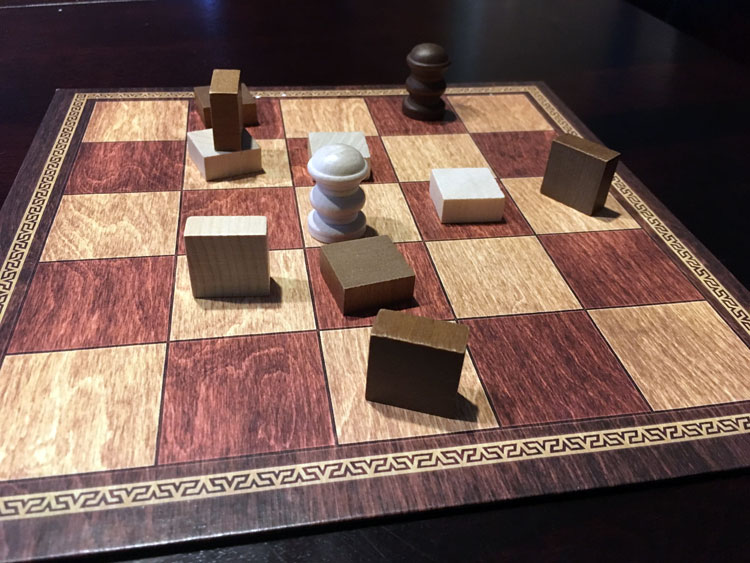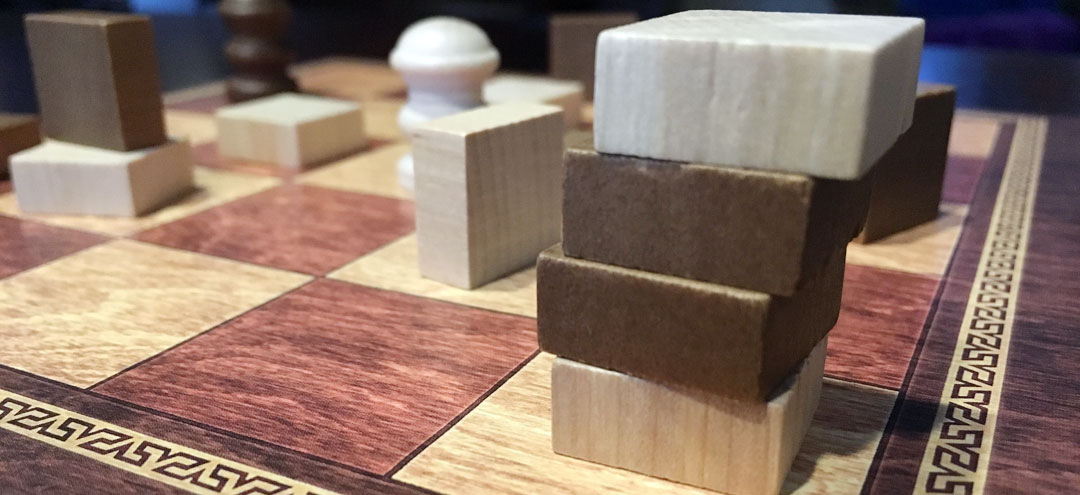 Tak has a unique origin. Patrick Rothfuss, an author of fantasy novels, created the concept and title of the game for his novel The Wise Man’s Fear, the follow up to The Name of the Wind. These novels center around a powerful hero, Kvothe, who has entered retirement and spends some time telling a traveler how he became the stuff of legend. One component of that tale has him learning and developing skill in the ostensibly fictional game of Tak.
Tak has a unique origin. Patrick Rothfuss, an author of fantasy novels, created the concept and title of the game for his novel The Wise Man’s Fear, the follow up to The Name of the Wind. These novels center around a powerful hero, Kvothe, who has entered retirement and spends some time telling a traveler how he became the stuff of legend. One component of that tale has him learning and developing skill in the ostensibly fictional game of Tak.
When Rothfuss created the idea of the game, he didn’t realize he would have the chance to see it in reality. Designer James Ernest took it upon himself to develop the game, using the content from the novel as a guide. The goal was to create an abstract strategy game with depth, replay value, and the ability to showcase the skill of the player through successive victories, as described in the book. It also had to look like it was thousands of years old.
The resulting abstract creation takes between 5 and 30 minutes for 2 players. Depending on time constraints, multiple games are ideal to decide a winner.
Gameplay Overview:
Before fully understanding the following description of rules, readers would do well to keep an open mind. While the game described shares some similarities with games seen as “kids games” there is an undercurrent to the purpose of these rules.

Gameplay begins with the choosing of the playing field. This is a square checkerboard of spaces. The space colors are irrelevant, but the play area needs to be four equal sides divided into a grid. For a ridiculously quick game, 3×3 can work. For longer games, 5×5 is standard. Anything above that, except 7×7 which is considered “unlucky” according to the game’s lore, can be played.
The pieces for the game come in two shapes. Flat stones (or just stones) are played vertically like a wall or horizontally like a floor. Capstones can be of any shape, but they more appropriately look like a piece of honor; a chess piece can even work.
The game starts with each player placing a piece of their opponent on the board. Then turns alternate with each player getting the choice to play a stone to an empty space or move a stack (even if only one) of stones. When a stone is played vertically (a wall) no other stones may be moved on top. Flat stones as a stack (even if only 1) can move onto other flat stones. The number of stones moved in a stack is equal to the size of the board (3 in a 3×3 board).
The special capstone piece can move with a stack and also can flatten vertical stones. In addition, stones cannot move on top of the capstone. This makes it a powerful commanding piece on the board.
The ultimate goal is to create a connection, a road, from one side of the board to the other with flat stones and/or the capstone.

Game Experience:
More than many other abstract games, Tak is different. It has a different kind of legacy and a different, almost elemental, kind of play style. While the rules take a couple of games of practice to remember, once ingrained, even a player with a modicum of experience can teach others.
But is it good? Yes. It is.

Tak stays with you. This reviewer has found himself remembering games from a couple of days ago, agonizing over how to play better, because losing especially teaches players. With Tak, the choices seem ridiculously simple. Description tends to fall back on Tic-Tac-Toe analogies, but it’s better than it appears on the surface. There is strategy. There are tactics (taktics?), and the psychology of a player comes into the game. That combination makes for an excellent abstract game.
What’s the main thing missing from Tak? In short, it doesn’t deliver the same punch at 3×3 and 4×4. If anything, grids of 5×5 are the perfect size for the game. Larger boards create tiresome games and smaller boards lose the capstone from play, creating a more bland strategy. With the “standard” or 6×6 size board, a trilogy of games can be played and feel satisfying.
Final Thoughts:
Tak is a great game. James Ernest could not have created a more appropriate or fun game for the concept from Patrick Rothfuss’ novel. The history of the game only underscores the unique challenge and strategy of the game. While comparisons to tic-tac-toe or Connect 4 may be heard, Tak offers more complexity and originality of play styles than those games. The player’s personality comes out and results in a wonderful game.
Final Score: 4.5 Stars – Despite lesser game experiences at different board sizes, Tak is a near perfect abstract game.
 Hits:
Hits:
• Strategy and Tactics
• Personalities of players emerges
• Classic aesthetic game design
Misses:
• Small issues at different board sizes























